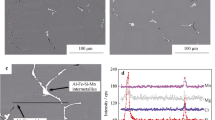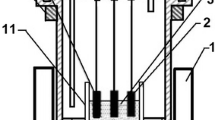Abstract
The anodic dissolution of Monel-400 (63.0% Ni, 28–34% Cu) alloy after its immersion in freely aerated stagnant 3.5% NaCl solutions for 0, 24, and 72 h has been investigated. The study was carried out using a variety of electrochemical techniques and gravimetric measurements after varied exposure periods (5–160 days). The work was complemented by scanning electron microscopy and energy dispersive X-ray analyzer (SEM/EDX) investigations. The electrochemical measurements showed that Monel suffers both general and pitting corrosion. The severity of uniform corrosion decreased, while pitting one increased with increasing the immersion time to 24 h and further to 72 h before measurements. Gravimetric data indicated that the weight loss increased, while the corrosion rate decreased for Monel with time. SEM images and EDX profile analyses confirmed that the corrosion of Monel after 160 days immersion in NaCl solutions occurs due to the selective dissolution of nickel.








Similar content being viewed by others
References
Ali JA (1994) Rotating ring-ring electrode study of copper component dissolution behaviour in air-saturated 0.5 M NaCl solution. Corros Sci 36:773–783
Lee HP, Nobe K (1984) Rotating ring-disk electrode studies of Cu-Ni alloy electrodissolution in acidic chloride solutions. J Electrochem Soc 131:1236–1243
North RF, Pryor MJ (1970) The influence of corrosion product structure on the corrosion rate of Cu–Ni alloys. Corros Sci 10:297–311
Walton ME, Brook PA (1977) The dissolution of Cu–Ni alloys in hydrochloric acid—I. Rotating disc electrode measurements. Corros Sci 17:317–328
Blundy RG, Proyor MJ (1972) The potential dependence of reaction product composition on copper–nickel alloys. Corros Sci 12:65–75
Kato C, Atteya BG, Castle JE, Pickering HW (1980) On the mechanism of corrosion of Cu-9.4Ni-1.7Fe alloy in air saturated aqueous NaCl solution. J Electrochem Soc 127:1890–1896
Petetin S, Crousier J, Crousier JP (1984) Comportement de l'alliage Cuivre-nickel 70/30 dans une solution de NaCl A 3%. Mater Chem Phys 10:317–329
Li W, Nobe K (1993) Electrodissolution kinetics of iron in chloride solutions. J Electrochem Soc 140:1642–1650
Milošev I, Metikoš-Huković M (1992) Factors influencing the breakdown susceptibility of the passive film on Cu–Ni alloy. Corrosion 48:185–193
Ulig HH (1963) Corrosion and corrosion control. Wiley, New York
Ghosh SK, Dey GK, Dusane RO, Grover AK (2006) Improved pitting corrosion behaviour of electrodeposited nanocrystalline Ni–Cu alloys in 3.0 wt.% NaCl solution. J Alloy Compd 426:235–243
Rangarajan S, Bera S, Narasimhan SV (1998) Electrochemical and surface analytical study of the formation of oxide films on monel-400 and copper in alkaline media. J Solid State Electrochem 2:94–98
Gagg CR, Lewis PR (2008) Environmentally assisted product failure—synopsis and case study compendium. Eng Fail Anal 15:505–520
Malik AU, Ahmad S, Andijani I, Al-Fouzan S (1999) Corrosion behavior of steels in Gulf seawater environment. Desalination 123:205–213
Gouda VK, Selim IZ, Khedr AA, Fathi AM (1999) Pitting corrosion behaviour of Monel-400 alloy in chloride solutions. Mater Sci Technol 15:208–212
Sherif EM, Park SM (2006) 2-Amino-5-ethyl-1,3,4-thiadiazole as a corrosion inhibitor for copper in 3.0% NaCl solutions. Corros Sci 48:4065–4079
Francis JT, McIntyre NS, Davidson RD, Ramamurthy S, Brennenstühl AM, McBride A, Roberts A (2002) Mechanisms for pitting corrosion in alloy N04400 as revealed by imaging XPS, ToF-SIMS and low-voltage SEM. Surf Interface Anal 33:29–34
Friend WZ (ed) (1980) Corrosion of nickel and nickel-based alloys. NACE International, Houston, TX
Stern M (1959) Evidence for a logarithmic oxidation process for stainless steel in aqueous systems. J Electrochem Soc 106:376–381
Streicher MA (1956) Pitting corrosion of 18Cr-8Ni stainless steel. J Electrochem Soc 103:375–390
Schwenk W (1964) Theory of stainless steel pitting. Corrosion 20:129t–137t
Sherif EM, Park SM (2005) Inhibition of copper corrosion in 3.0% NaCl solution by N-phenyl-1,4-phenylenediamine. J Electrochem Soc 152:B428–B433
Sherif EM, Park SM (2006) Effects of 2-amino-5-ethylthio-1,3,4-thiadiazole on copper corrosion as a corrosion inhibitor in aerated acidic pickling solutions. Electrochim Acta 51:6556–6562
Sherif EM, Park SM (2006) Inhibition of copper corrosion in acidic pickling solutions by N-phenyl-1,4-phenylenediamine. Electrochim Acta 51:4665–4673
Bohni H, Uhlig HH (1969) Environmental factors affecting the critical pitting potential of aluminum. J Electrochem Soc 116:906–910
Ali JA, Ambrose JR (1992) The relationship between copper component dissolution kinetics and the corrosion behaviour of monel-400 alloy in de-aerated NaCl solutions. Corros Sci 33:1147–1159
Rozenfeld IL, Marshakov IK (1964) Mechanism of crevice corrosion. Corrosion 20:115t–125t
Sherif EM (2006) Effects of 2-amino-5-(ethylthio)-1,3,4-thiadiazole on copper corrosion as a corrosion inhibitor in 3% NaCl solutions. Appl Surf Sci 252:8615–8623
Sherif EM, Almajid AA (2010) Surface protection of copper in aerated 3.5% sodium chloride solutions by 3-amino-5-mercapto-1,2,4-triazole as a copper corrosion inhibitor. J Appl Electrochem 40:1555–1562
Sherif EM (2010) Corrosion mitigation of copper in acidic chloride pickling solutions by 2-amino-5-ethyl-1,3,4-thiadiazole. J Mater Eng Perform 19:873–879
Sherif EM, Erasmus RM, Comins JD (2010) In situ Raman spectroscopy and electrochemical techniques for studying corrosion and corrosion inhibition of iron in sodium chloride solutions. Electrochim Acta 55:3657–3663
Sherif EM, Almajid AA, Latif FH, Junaedi H (2011) Effects of graphite on the corrosion behavior of aluminum–graphite composite in sodium chloride solutions. Inter J Electrochem Sci 6:1085–1099
Sherif EM, Ahmed AH (2010) Synthesizing new hydrazone derivatives and studying their effects on the inhibition of copper corrosion in sodium chloride solutions. Synth React Inorg Met-Org Nano-Metal Chem 40:365–372
Sherif EM (2011) Corrosion and corrosion inhibition of aluminum in Arabian Gulf seawater and sodium chloride solutions by 3-amino-5-mercapto-1,2,4-triazole. Inter J Electrochem Sci 6:1479–1492
Sherif EM, Erasmus RM, Comins JD (2008) Inhibition of copper corrosion in acidic chloride pickling solutions by 5-(3-aminophenyl)-tetrazole as a corrosion inhibitor. Corros Sci 50:3439–3445
Sherif EM, Potgieter JH, Comins JD, Cornish L, Olubambi PA, Machio CN (2009) Effects of minor additions of ruthenium on the passivation of duplex stainless-steel corrosion in concentrated hydrochloric acid solutions. J Appl Electrochem 39:83–91
Sherif EM, Potgieter JH, Comins JD, Cornish L, Olubambi PA, Machio CN (2009) The beneficial effect of ruthenium additions on the passivation of duplex stainless steel corrosion in sodium chloride solutions. Corros Sci 51:1364–1371
Klassen RD, Roberge PR, Wang Y (2005) Corrosion Resistance of UNS NO4400 vs. electroless nickel in simulated marine service. Corrosion (NACE) Paper No. 05232
Ma H, Chen S, Niu L, Zhao S, Li S, Li D (2002) Inhibition of copper corrosion by several Schiff bases in aerated halide solutions. J Appl Electrochem 32:65–72
Sherif EM, Erasmus RM, Comins JD (2007) Effects of 3-amino-1,2,4-triazole on the inhibition of copper corrosion in acidic chloride solutions. J Colloid Interface Sci 311:144–151
Sherif EM, Erasmus RM, Comins JD (2007) Corrosion of copper in aerated acidic pickling solutions and its inhibition by 3-amino-1,2,4-triazole-5-thiol. J Colloid Interface Sci 306:96–104
Sherif EM, Erasmus RM, Comins JD (2007) Corrosion of copper in aerated synthetic sea water solutions and its inhibition by 3-amino-1,2,4-triazole. J Colloid Interface Sci 309:470–477
Acknowledgments
This project was supported by King Saud University, Deanship of Scientific Research, College of Engineering Research Center.
Author information
Authors and Affiliations
Corresponding author
Rights and permissions
About this article
Cite this article
Sherif, ES.M. Effects of exposure time on the anodic dissolution of Monel-400 in aerated stagnant sodium chloride solutions. J Solid State Electrochem 16, 891–899 (2012). https://doi.org/10.1007/s10008-011-1438-0
Received:
Revised:
Accepted:
Published:
Issue Date:
DOI: https://doi.org/10.1007/s10008-011-1438-0




